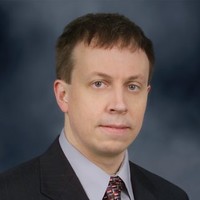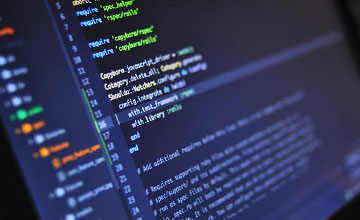
Thomas J. Barnard
- Courses1
- Reviews1
- School: Syracuse University
- Campus:
- Department: Computer Science
- Email address: Join to see
- Phone: Join to see
-
Location:
900 S Crouse Ave
Syracuse, NY - 13244 - Dates at Syracuse University: August 2016 - August 2016
- Office Hours: Join to see
Biography
Syracuse University - Computer Science
Resume
7936304
This invention relates to the use of a sufficiently-sampled auxiliary array in combination with one or more under-sampled sub-arrays. The sufficiently-sampled auxiliary array is used to create a signal-free reference (SFR) beam that contains grating lobe interference. The SFR may be used to cancel the interfering grating lobe in an under-sampled main beam by coherently eliminating or subtracting the SFR from the main beam. Exemplary aspects of the invention thus support significant under population of the full aperture and avoid the problems and limitations of previous solution
with consequent savings in sensor hardware cost and weight.
Method and System for Isolating and Reducing Grating Lobes
T Canavan
7228236
A method of beam forming an array
by computer processing a cross covariance
of the reference sub array seismic signal data signal
by having an unknown shape comprising receiving acoustic signals
via the array
and computing the data and segmenting the array into an initial segment of a known shape and at least a second segment
and beam forming the initial segment to provide a beam formed output
and using the beam formed output to obtain weights
for the second segment of the array.\r\n
Sub-Array Matching Beamformer Apparatus and Method
M Fernandez
6868044
A technique for suppressing interference with unknown phase shifts received by an array of sensor elements partitions the array into a plurality of subarrays. Each subarray is processed independently to suppress the interference. Next
the resulting data from each subarray are summed together. This summed data
which effectively represents data provided by the full array with interference suppressed
may be utilized to detect and/or localize a target of interest. Each subarray is processed independently of all other subarrays. No cross-subarray processing is required. This technique is applicable to linear arrays
multi-line arrays
planar arrays
cylindrical arrays
conformal arrays
and spherical arrays. Applicable sensors include acoustic sensors (e.g.
sonar
ultrasonic)
electromagnetic sensors (e.g. radar)
and optical sensors (e.g.
infrared
ultraviolet
visible light).
Data Adaptive Interference Suppression
D.D. Winfield
6594201
A system and process for localizing signals received on multiple co-linear arrays reduces the adverse effects on localization performance due to background noise. The system and process coherently combine all possible array cross-correlograms. The resulting correlogram is a function of two variables
one which corresponds to a fine bearing estimate and a second with maps into range.
System and method for localizing targets using multiple arrays
D Winfield
6545639
A system and process for maintaining correlated contacts (e.g.
sonar/radar contacts) utilizes diagonal averaging. A covariance matrix is formed from signals received by an array of sensors. These sensors may be acoustic and/or electromagnetic sensors. The covariance matrix is replaced with Toeplitz matrix. The Toeplitz matrix is a Toeplitz matrix that most closely matches the covariance matrix in the least squares sense. The Toeplitz matrix is used to calculate weight vectors for the adaptively formed response signals.\r\n
System and method for processing correlated contacts
2010
Stevens Institute of Technology
For the Systems Engineering department at Stevens
I am the Professor for Lockheed Martin’s Technical Development Curricula
used in conjunction with their Engineering Leadership Development Program. In this capacity I generate technical content
and give a host of virtual lectures on Systems Engineering and Systems Analysis. This content spans four courses worth 12 graduate credits in Systems Engineering. The goal is to give all of the new engineers across multiple lines-of-business a common understanding of Systems Engineering discipline.
Adjunct Professor
Syracuse
New York Area
Stevens Institute of Technology
2007
Syr
The Integrated Warfare Systems & Sensors (IWSS) line of business within Lockheed Martin has a $35M Internal Research & Development (IRAD) portfolio
spanning work across three different states. I was responsible for ensuring that all projects meet technical
cost and schedule objectives while adhering to Lockheed Martin engineering processes and compliance with federal regulations. Other responsibilities include generation of the IWSS Technology Investment Plan. This involves meeting with key stakeholders and lead engineers to identify critical technologies
and then working with program management and business development to determine the appropriate fulfillment means.
IRAD / Technology Manager
Lockheed Martin MST
As chairman IWSS Intellectual Property Review Board
I ran a group that reviews employee-submitted invention disclosures and decides which merit patent pursuit (50+ per year). This involves working with inventors from diverse technical backgrounds to help them develop a clear
concise description of the concept and the associated business case.
Intellectual Property Manager
Syracuse
New York Area
Lockheed Martin MST
Syracuse
New York Area
As the Edelstein Professor of Practice for the Department of Electrical Engineering and Computer Science at Syracuse University
I engage in teaching
curriculum development
and advising. More specifically
I am developing programs of study in Systems Engineering. I also teach graduate level courses in Radar Tracking
Adaptive Processing
Modeling and Simulation
and Non-Gaussian Clutter Rejection.
Professor of Practice
Syracuse University
1994
Syracuse University
Syracuse
New York Area
Lockheed Martin’s radar and electro-optical/infrared sensor systems provide advanced precision targeting
navigation
threat detection and next generation intelligence
surveillance and reconnaissance capabilities. We’ve designed and delivered radars and sensors for every armed service and operational environment.
System Engineer
Lockheed Martin Rotary and Mission Systems
For the department of Electrical Engineering at SU I have taught graduate courses in Probability
Radar Engineering
Tracking
Adaptive Processing
and Non-Gaussian Clutter Rejection.
Adjunct Professor
Syracuse
New York Area
Syracuse University
Online
I teach Business Math for the Southern New Hampshire University online MBA program. Topics include finance
derivatives
probability & statistics. The work involves online instruction & interaction with 25 students per 10 week semester.
Adjunct Faculty
Southern New Hampshire University
Raleigh-Durham
North Carolina area
I provide consulting services for Fuentek -- a trusted adviser in the technology transfer
business development
and R&D community at university
government
and corporate organizations worldwide. We assess innovations for commercialization and analyze market research. My technical expertise includes systems engineering
signal processing
adaptive processing
and tracking.
Technology Transfer Consultant
Fuentek
LLC
1989
Doctor of Philosophy (Ph.D.)
My Doctoral thesis addressed detection theory and non-Gaussian clutter rejection
Electrical Engineering
Syracuse University
1986
Thomas
Barnard
Ph. D.
Lockheed Martin MST
Syracuse University
Southern New Hampshire University
Fuentek
LLC
Lockheed Martin Rotary and Mission Systems
For over 26 years at Lockheed Martin Corporation (and the heritage General Electric)
my work has addressed research & development
modeling and simulation
and systems analysis. More specifically
this includes the design and test of adaptive beamformers
space-time adaptive processors (STAP)
interference cancellation algorithms
and non-Gaussian detectors for clutter rejection. I hold 5 US patents and have numerous publications in peer-reviewed journals and conference proceedings.
Principle Research Engineer
Syracuse
New York Area
Lockheed Martin MST
Master of Science Electrical Engineering
Syracuse University
1982
Bachelor of Science Electrical Engineering
Bucknell University
Simulations
R&D
Public Speaking
Earned Value Management
Engineering
Project Management
Technical Writing
Analysis
Research
Engineering Management
DoD
Sensors
Intellectual Property Valuation
Teaching
Program Management
Algorithms
Systems Engineering
Signal Processing
Microsoft Office
Testing
Statistical Normalization of Spherically Invariant Non-Gaussian Clutter
F. Khan
Statistical Normalization of Spherically Invariant Non-Gaussian Clutter
D.D. Weiner
Non-Gaussian Clutter Generation and Approximation With Generalized Spherically Invariant Random Vectors
A. Pennise
An Evaluation of Selective Adaptive Beamforming Against Recorded Shallow Water Active Classification Data
M Thelen
M. Fernandez
A. Aridgides
Adaptive Clutter Suppression for Enhanced Active Sonar Operation in Shallow Water
F. Khan
False Alarm Rate Reduction in Active Sonar Using Spherically Invariant Random Vectors for Clutter Suppression
